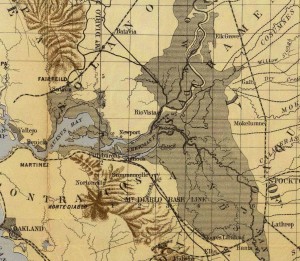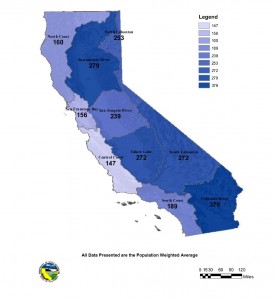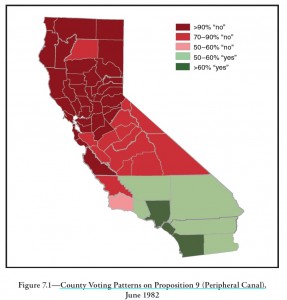
Sacramento Delta, 1874, courtesy David Rumsey Map Collection
When the US government’s Board of Commissioners on the Irrigation of the San Joaquin, Tulare, and Sacramento Valleys of the State of California duly reported to Congress in 1874, its members issued a warning. If a plan for irrigating the rich but arid lands of California’s great Central Valley is not worked out with care
the result will be a partial and temporary good for only a part of the valley, and will lead to an intricacy of endless legal troubles.
Gen. B.S. Alexander of the Army Corps of Engineers and his fellow commissioners had something fairly specific in mind with their criticism – that water development shouldn’t be done helter-skelter, but should be planned. First, the tools of science should be used to survey the place and determine where best irrigation might be accomplished. After which
the laws under which a proper system of irrigation for the great valley can then be decided upon intelligently.
We haven’t entirely worked out that first part, and we seem to have bollixed up the second part, the development of governance structures, completely.
I got sidetracked by Gen. B.S. Alexander’s report as I was trying this weekend to dig through reactions to last week’s vague rollout of the latest aspects of the Bay Delta Conservation Plan, the infrastructure and accompanying governance being contemplated as part of the latest iteration of Alexander’s ideas.
Reactions have ranged from the tepid to the fire-breathing. They served primarily to illustrate the ways in which California’s current process has failed to capture the principles the late Elinor Ostrom outlined as being central to successfully solving common pool resource problems. Here’s economist Gernot Wagner’s explanation:
Everyone wants a say in setting up the rules. Not everyone’s advice will be heeded, but everyone at the very least will be heard. That’s not just an act in futile pseudo-democracy; it’s key for keeping everyone on board and committed.
If you buy Ostrom’s argument, it’s hard to imagine a worse way to approach the management of a common-pool resource than the BDCP process. The water users who will be consuming the water coming out of the Delta and paying for the infrastructure needed to ensure its continued delivery are on the inside of the BDCP process. Lots of other players feel completely left out.
But it’s worth recalling why the BDCP is that way, and what the BDCP is and what it is not. Perhaps therein lies some daylight.
First and foremost, BDCP is not supposed to be a common pool resource management process. That’s what it’s ended up as, by default, but that was not the intent of the bureaucratic process at its core. If you look at the original BDCP Planning Agreement (pdf), you’ll find a process constructed not with the purpose of dividing up California’s waters and figuring out how to move them hither and yon in the manner suggested a century ago by Gen. Alexander, but rather something much narrower – a process aimed at providing “clear expectations and regulatory assurances regarding Covered Activities occurring within the Planning Area.” “Covered Activities” is jargon for stuff you do that might kill fish, some of which are endangered.
That we’ve ended up with a proposal for a tunnel to carry 9,000 cubic feet per second of water beneath the Delta is not the result of an effort to figure out how to best manage water. It’s the result of any effort to buy “regulatory assurances” that agricultural and municipal water users won’t have their supplies shorted because they run afoul of state and federal endangered species laws. There are some who might argue that the two are one and the same, but they are not necessarily so.
In other words, the BDCP is not and never has been about a process for solving a pressing common pool resource problem. This is about offering water users “regulatory assurance” about how much water they’ll be able to extract from the system without ending up in court on the wrong end of an Endangered Species Act lawsuit, and what those water users will have to offer in return to help buy that regulatory assurance.
That may have been the most interesting part of last week’s rollout is the very explicit acknowledgment of this reality in economist David Sunding’s benefits analysis. I’ve only seen Sunding’s slides – I didn’t hear his talk, and we don’t have his full report yet. So I can’t comment on his results, only on the general principle he’s arguing – that the value in being certain that their supplies won’t be curtailed is (or should be) of substantial value to water managers. As OtPR put it:
Reliability for urban drinking water for 25 million people is really fucking valuable.
The problem may be that this process can’t really buy reliability. Jeff Michael argues there are important questions about whether the BDCP process will really be able to provide the regulatory certainty that supposed to be its core purpose. I don’t know enough about the ESA nuances to know if he’s right, but if he is, it would torpedo the BDCP process. Which would leave California with its common pool resource problem of managing the water flows through the Sacramento Delta untouched.
In our search for an Ostromian holy grail of common pool resource problem solving, that would still leave us with the Delta Stewardship Council process. But that’s the topic for another post.





